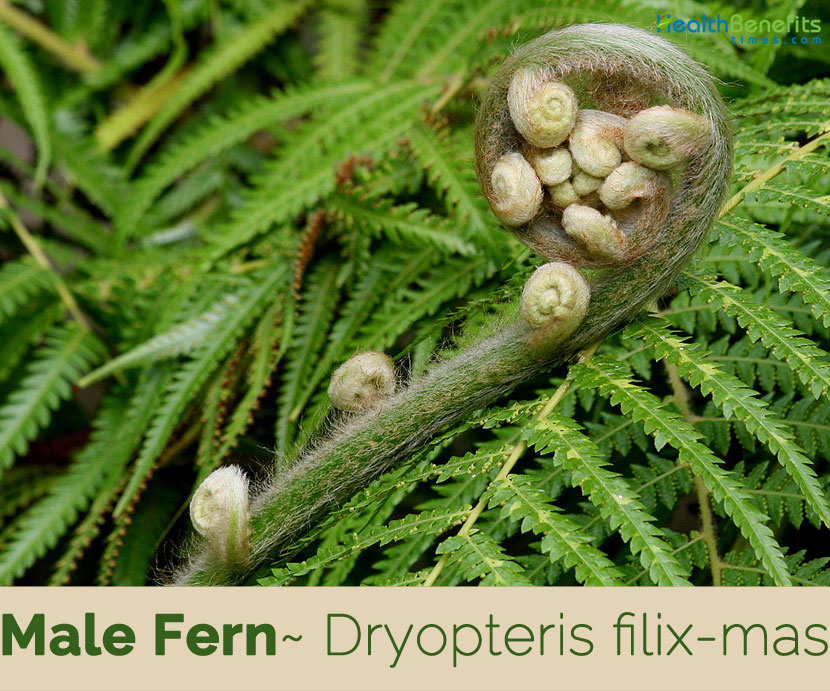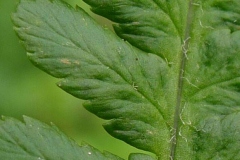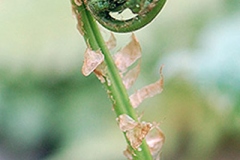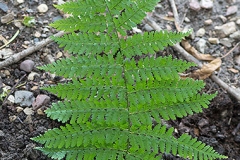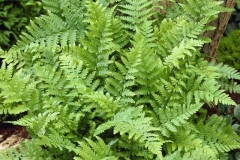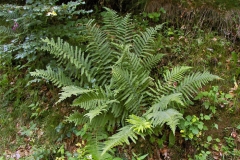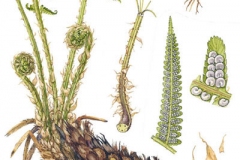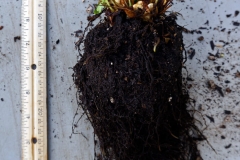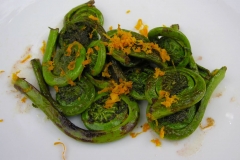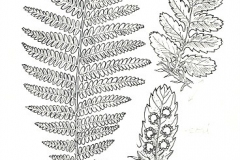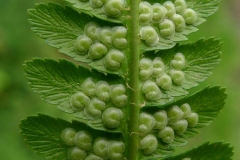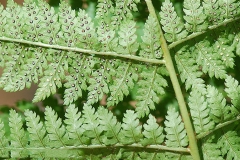| Male Fern Quick Facts | |
|---|---|
| Name: | Male Fern |
| Scientific Name: | Dryopteris filix-mas |
| Origin | Much of Europe, Asia, and North America |
| Taste | Somewhat bitter astringent and nauseous taste |
| Health benefits | Beneficial for tape worms, internal hemorrhage, uterine bleeding, mumps, feverish illnesses, abscesses, boils, carbuncles, sores, recurrent nosebleeds, and heavy menstrual bleeding |
| Name | Male Fern |
|---|---|
| Scientific Name | Dryopteris filix-mas |
| Native | Temperate Northern Hemisphere, native to much of Europe, Asia, and North America |
| Common Names | Aspidium, Bear’s paw, Knotty brake, Male fern, Marginal fern, Shield fern, Worm fern, Sweet Brake, Dryopteris, Japanese flowering fern rhizome, Male fern rhizome, bear’s paw, helecho macho, wurmfarn |
| Name in Other Languages | Albanian: Driopter, fieri mashkull Arabic: Qarfas Armenian: Vahanapter arakan (Վահանապտեր արական) Azerbaijani: Erkək ayıdöşəyi Basque: Iratze ar, iratze arra, iziarra Belarusian: Paparaci mužčynskaja (Папараць мужчынская) Bengali: Pankhraj Bulgarian: Mŭzhka paprat (мъжка папрат), mŭzhka paprat (мъжка рапрат), protivolistna paprat (противолистна папрат) Catalan: Falguera mascle, Falguera de muntanya, Falguerola, Falzia mascle, falguera alta Chinese: Ou zhōu lín máo jué, 欧洲鳞毛蕨, Gu Sui Bu, Guan Zhong Croatian: Sumska paprat Czech: Kapraď samec Danish: Almindelig mangeløv Dutch: Mannetjesvaren English: Male fern, Male woodfern, Male-fern, Malefern, common male fern Erzya: Atyaşkerge (Атяшкерьге) Esperanto: Vera driopterido Estonian: Maarja-sõnajalg Finnish: Kivikkoalvejuuri French: Dryoptère fougère-mâle, fougère male, polystic fougère-mâle Galician: Fento macho Georgian: chaduna (ჩადუნა) German: Gemeiner Wurmfarn, Gewöhnlicher Wurmfarn, echter Wurmfarn, Echtwurmfarn, Greek: Arrenopteri (αρρενόφτερη) Hungarian: Erdei pajzsika Icelandic: Stóriburkni Irish: Raithneach mhadra Italian: Felce maschio, felce maschio comune Kazakh: Usasır (Усасыр) Kurdish: Tilîper Latvian: Melnā ozolpaparde, vīrpaparde Lithuanian: Kelminis papartis, kelminis papartis Northern Sami: Juovvagáiskkit Norwegian: Bu-jæske, Groste, Grønt molfoor, Han-blom, Klojæske, Molfoor, Molfoorblom, Ryste-blom, Ormetelg Occitan: Faugiere bastarda Persian: Keel daru, نرسرخس Polish: Nerecznica samcza Portuguese: Dentebrura, denteburra, fentanha-macha, fento-macho, feto-macho Quechua: Urqu raki-raki Romanian: Ferigă, ferigă comună Russian: Shchitovnik muzhskoy (Щитовник мужской) Serbian: Obična paprat (Обична папрат), навала, obična navala (обична навала), tsevasta paprat (црваста папрат) Slovak: Papraď samčia Slovene: Navadna glistovnica Spanish: Navadna glistovnica, dentabrón, helecho macho Swedish: Kivikkoalvejuuri, Träjon Tamil : Hirvi, Iruvi Tatar: Паразитларга каршы дарыу Turkish: Erkek eğrelti Ukrainian: Paporotʹ cholovicha (Папороть чоловіча), shchytnyk cholovichyy (щитник чоловічий) Urdu: Sarakhs Walloon: Fetchire måye Welsh: Marchredynen gyffredin |
| Plant Growth Habit | Large, hardy, vigorous, semi-evergreen, clump-forming ornamental fern |
| Growing Climates | Rich woods, glades, upland pastures, hardwood to mixed forest, rocky groves, rocky grove slopes, cliff bases and rock fields, damp shaded areas in the understory of woodlands shady places on hedge-banks and screes |
| Soil | Easily grown in average, medium moisture, well-drained soils. Prefers consistently moist, humusy soils that are rich in organic matter. Soils should not be allowed to dry out |
| Plant Size | Up to 1-3 feet tall and almost equal spread |
| Rhizome | Erect, stout, branching, covered with old stipe bases |
| Frond | Fronds are usually dark green in color. The blades are ovate to narrowly lanceolate, up to 12 inches wide, widest about 1/3 of the way up from the base and gradually narrowing to a pointed tip |
| Pinnae | Young fronds can give the appearance of pinnae tilted upward from the blade plane, similar to those of the Crested Fern |
| Sori | Sori are on the upper half of the frond, at the back of the pinnules, in round masses towards the base of the segments, covered with a conspicuous, kidney shaped thin membrane |
| Flower | This is a non-flowering plant |
| Flavor/Aroma | Slight disagreeable odor |
| Propagation | Spores, division |
| Taste | Somewhat bitter astringent and nauseous taste |
| Plant Parts Used | Root, leaves, rhizomes |
| Available Forms | Extract, an extract draught, capsules |
| Lifespan | |
| Season | July to September |
Plant Description
Male Fern is a large, hardy, vigorous, semi-evergreen, clump-forming ornamental fern that normally grows up to 1-3 feet tall and almost equal spread. The plant is found growing in rich woods, glades, upland pastures, and hardwood to mixed forest, rocky groves, rocky grove slopes, cliff bases and rock fields, damp shaded areas in the understory of woodlands shady places on hedge-banks and screes. The plant is easily grown in average, medium moisture, well-drained soils. It prefers consistently moist, humusy soils that are rich in organic matter. Soils should not be allowed to dry out.
Rhizomes
Rhizome or tuber of the male fern is reddish brown in color and is usually small, bulky and scaled. The root – stock or rhizome is short, stumpy and creeping, lying along the surface of the ground or just below it. From it’s under surface spring the slender, matted roots. The crown of the rhizome is a brown, tangled mass, with the hairy bases of the leaves, and in it is contained the mass of undeveloped fronds which, as they unroll, grow in a large circular tuft. The rhizome is brownish black, ovoid-cylindrical pieces about 6-15cm long and 3-4 cm in diameter. The rhizome used is three to six inches long, and with the closely imbricated and slightly curved remnants of the stipes two to three inches thick. The latter remains green for about a year after which it turns brown. The rhizome is fleshy, externally dark brown, internally pale green and spongy. On transverse section near the surface eight larger fibro vascular bundles arranged in an interrupted circle, outside of which are a number of smaller ones. The stipes has about eight small vascular bundles in a loose circle. The spongy texture is due to the thin walled parenchyma and to the large intercellular spaces, into which stalked glands project which exude a green liquid. The rhizome has a slight disagreeable odor and a sweetish afterward, somewhat bitter astringent and nauseous taste.
Fronds
The plant bears insipid green leaves also known as fronds. Fronds are usually dark green in color. The blades are ovate to narrowly lanceolate, up to 12 inches wide, widest about 1/3 of the way up from the base and gradually narrowing to a pointed tip. There is no visual difference between the fronds that have fertile sori and those that may not. There are no aromatic glands. Fronds are firm, not leathery, and die back in the fall, but may remain green overwinter. The central rachis is green with pale tan scales on the underside. The grooved stipe is quite short, forming less than 1/4 the length of the frond. The brown scales of the stipe are distinctive, being of two kinds – one hair-like and one broad. Fiddleheads emerge almost covered with the scales.
Pinnae
The pinnae are narrow and pointed to the tip with the basal pinnae much reduced in size. Pinnae are mostly in the plane of the blade, but young fronds can give the appearance of pinnae tilted upward from the blade plane, similar to those of the Crested Fern. Also, the lower Pinnae are shorter and somewhat tilted downward, similar to some other members of the Dryopteris. The division pattern is pinnate-pinnatifid and sometimes bi-pinnate near the base. On the rachis, the pinnae are not opposite each other but slightly offset. The upper side of the costa is grooved but the groove does not meet the groove on the rachis.
Pinnules
There will be 24+/- pairs of short pinnules on the pinnae. Margins of the pinnules are lobed and the lobes are slightly toothed, with pointed lobe tips at the end of the pinnule veins. There is no difference in length of the adjacent basal pinnules.
The sori are on the upper half of the frond, at the back of the pinnules, in round masses towards the base of the segments, covered with a conspicuous, kidney shaped thin membrane. On the underside of the fronds, there are two rows of dark brown spores.
History of Male Fern
Male fern is native to the temperate climates of Asia, Europe, and much of South and North America. The plant is highly adaptable and can grow well in both arid and fertile soils. Root of the male fern, usually harvested in early autumn, is dried for therapeutic purposes. As far back as 103 A.D., Greek and Roman physicians used the male fern root to help expel harmful organisms from the intestines and digestive tract. In fact, it is rumored that Louis XVI of France paid large sums of money to add this powerful fern to his own medicine chest.
Traditional uses and benefits of Male Fern
- Male fern is one of the most popular and effective treatments for tape worms.
- Root stalks are anodyne, antibacterial, anti-inflammatory, antiviral, astringent, febrifuge, vermifuge and vulnerary.
- Root consists of an oleoresin that paralyses tapeworms and other internal parasites and has been used as a worm expellant.
- An oily purge, such as castor oil, increases the absorption of the fern root and can be dangerous.
- Root is also taken internally in the treatment of internal hemorrhage, uterine bleeding, mumps and feverish illnesses.
- The root is harvested in the autumn and can be dried for later use.
- Externally, the root is used as a poultice in the treatment of abscesses, boils, carbuncles and sores.
- Male fern has been used in traditional medicine as a vermifuge, with the early Greeks and Romans also recognizing the plant’s value in destroying or expelling parasitic worms.
- In Chinese medicine, the extract has been used to treat wounds, recurrent nosebleeds, and heavy menstrual bleeding.
- The components of the plant have also been used as veterinary vermifuges.
- Male Fern may support healthy blood lipid levels, benefits hair health, promotes bone health and healing, benefits joint health, may rid parasites such as tapeworms and supports healthy kidney function.
Culinary Uses
- Young fronds can be consumed after being cooked.
- It has a flavor resembling asparagus, broccoli and artichokes.
- The rhizomes can be eaten raw or cooked.
- They were eaten raw as part of a regime for losing weight.
- In times of great scarcity the Norwegians used the fronds to mix with bread and also made them into beer.
Other Facts
- Compost of fern leaves is very beneficial on tree seed beds, aiding germination.
- Ashes of the plant are rich in potash and have been used in making soap and glass.
- It is an effective ground cover plant.
- Although it is usually deciduous, its decaying fronds make good weed-suppressing mulch in the winter.
- The leaves, cut green and dried, make an excellent bitter, and when infused in hot water make good fodder for sheep and goats.
- Some veterinarians use male fern to treat worms in animals.
Precautions
- Large quantities can cause severe health problems.
- People with heart complaints should not be recommended this plant.
- It is highly toxic.
- It may cause Nausea, headache, diarrhea and dizziness.
- Avoid use during pregnancy and breast feeding.
- Do not consume more than 6-8 grams.
- Male fern also may increase bilirubin and albumin levels in the blood.
- Severe poisoning from the herb may cause respiratory failure, seizures, optic nerve pain, heart failure, coma, and death.
- Don’t use male fern if you’re elderly or debilitated.
- Don’t give this herb to infants.
- Avoid male fern if you have anemia, ulcers, or a disease of the heart, liver, or kidney.
- If you’re taking prescribed drugs to treat a liver condition, check with your health care practitioner before using male fern.
References:
https://www.itis.gov/servlet/SingleRpt/SingleRpt?search_topic=TSN&search_value=17535#null
https://pfaf.org/user/Plant.aspx?LatinName=Dryopteris+filix-mas
http://www.missouribotanicalgarden.org/PlantFinder/PlantFinderDetails.aspx?taxonid=285742
http://www.floracatalana.net/dryopteris-filix-mas-l-schott
https://www.drugs.com/npp/male-fern.html
https://www.botanical.com/botanical/mgmh/f/ferns-08.html#mal
https://plants.usda.gov/core/profile?symbol=DRFI2
https://en.wikipedia.org/wiki/Dryopteris_filix-mas
https://davesgarden.com/guides/pf/go/106132/#b
https://www.wikidata.org/wiki/Q322994
https://hardyfernlibrary.com/ferns/listSpecies_Auto_6.html
http://www.theplantlist.org/tpl1.1/record/tro-26602214
https://gd.eppo.int/taxon/DYOFM
http://www.jetir.org/papers/JETIR1905M34.pdf


